Costa Rica—the land of la pura vida—has a lot to offer. Whether you’re seeking adrenaline-fueled adventure, or good-old rest and relaxation, the land of the pure life does not disappoint. If the promise of white-sand beaches, rain-soaked jungles and thrilling outdoor adventure is calling you, this guide will highlight the following:
- Why Visit Costa Rica?
- The Top Destinations in Costa Rica
- The Top Outdoor Activities in Costa Rica
- How to Plan Your Trip
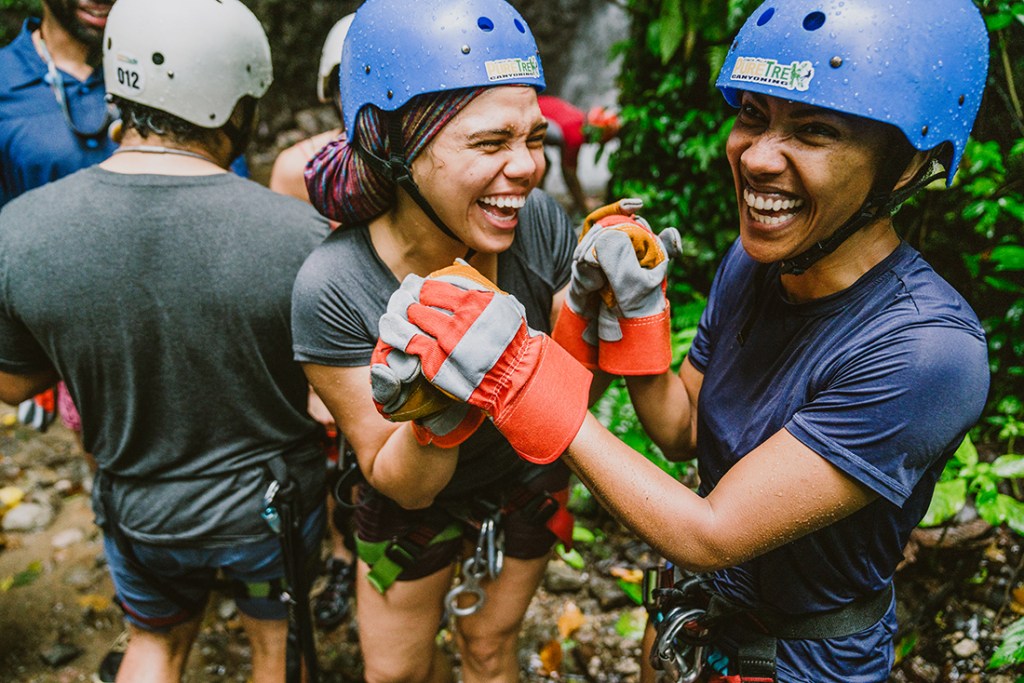
Travelers share the excitement of a canyoning excursion.
Although Costa Rica appeals to outdoor, wellness and wildlife enthusiasts, its culture certainly adds to the country’s charm. Costa Rica is essentially a melting pot, blending Spanish, African, Chinese, Jewish, Lebanese and Italian cultures with those of its indigenous peoples, including the Bribrí, Cabécar, Maleku, Teribe, Boruca, Ngäbe, Huetar and Chorotega groups.
The result? A land filled with vibrant artistic expression, such as creole swing dance, Limón calypso, and traditional Chorotega ceramics, not to mention festivals and flavorful cuisine.
Why Visit Costa Rica?
As Costa Rica travel continues to gain in popularity, the country is devoted to keeping environmental conservation as a top priority. The small country is within the top 20 of the world’s richest countries when it comes to biodiversity, which is quite impressive when you consider its size. In fact, nearly 500,000 species of fauna and flora, representing approximately 5 percent of the Earth’s biodiversity, can be found within the country’s 19,730 square miles.
Costa Rica’s dedication to the environment is so strong that it declared its goal of becoming the world’s first decarbonized country by launching “The National Decarbonization Plan 2018-2050” earlier this year.
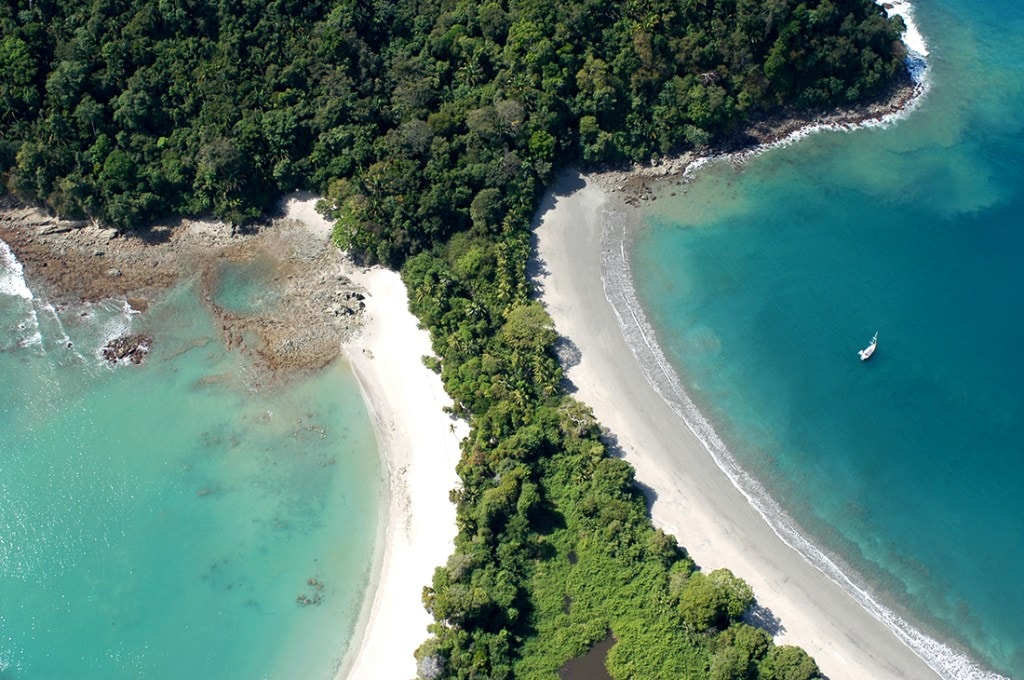
A country of rich biodiversity, Costa Rica is a thrill to explore on both land and sea.
“Decarbonization is a commitment of Costa Rica with current and future generations. It means transforming the development model to a sustainable one, free of fossil fuels, that improves the country’s competitiveness and the quality of life of people,” said Carlos Manuel Rodriguez, the country’s minister of environment and energy, in a speech at the government’s initiative launch in February 2019.
“The goal is to be a country with net zero emissions by 2050,” he added. “These transformations are not new to the country; we have done it before. We are a tropical country that stopped deforestation and tripled our per capita income, which generates 99 percent of our electricity from renewable sources.”
Similar to America’s National Park Service, Costa Rica’s National System of Conservation Areas, established in 1998, already preserves about 26 percent of the country’s land mass, including its volcanoes, beaches, and myriad forests and jungles.
The Top Travel Destinations in Costa Rica
Costa Rica is divided into seven regions, each with its own unique personality and offerings. Before choosing which region to visit, it’s best to consider what experiences you’d like to have during your trip. It is possible to travel from one region to the next, but it is important to consider that travel takes time, and it may be best to not pack too much into your Costa Rica visit. Remember, when in Costa Rica, do as the Ticos (locals) do, and embrace la pura vida.
Guanacaste
In the northwest of Costa Rica, along the Pacific Ocean, lies Guanacaste. In addition to its 400 miles of coastline, Guanacaste, Santa Rosa and Rincon de la Vieja national parks are found here. Within the 70,000 acres that comprise Guanacaste National Park, which is part of the Guanacaste Conservation Area and a UNESCO World Heritage site, are the Orosi and Cacao volcanoes.
Though a national park, the roads within Guanacaste are unpaved and difficult to travel; the park is mainly visited by researchers and students. As such, all visits to Guanacaste National Park must be coordinated through Santa Rosa National Park.
Santa Rosa National Park is easier to visit. Wildlife enthusiasts will delight in its dry tropical forest (nearly six rain-free months annually) and superlative wildlife viewing opportunities, from white-tailed deer to howler and white-faced monkeys to the Olive Ridley sea turtles that nest on the park’s two beaches, Naranjo and Nancite.

Ever dreamed of rappelling down a waterfall? On this trip, you can.
Smaller than the other two parks, Rincon de la Vieja National Park is inland and has its own volcano too. Although hiking is a main attraction here, the hot springs, waterfalls and impressive variety of wildlife shine brightly as well. The inland areas of the Guanacaste region are also popular for outdoor adventure, including zip-line tours through the treetops, whitewater rafting and river tubing.
Puntarenas
Just south of Guanacaste is the Puntarenas region, which is blessed with a coastline dotted by small islands. A superb one to visit is Cocos Island National Park, which has been designated a UNESCO World Natural Heritage site because of its rich marine life. How rich? The waters that surround the island are home to 600 species of marine mollusks, 300 species of fish and 32 species of coral.
From sea level, Puntarenas stretches inwards and upwards to Monteverde, home to the Monteverde Cloud Forest Reserve and the Santa Elena Cloud Forest Reserve, both incredibly rich in biodiversity, including colorful frogs and birds. Carara National Park is here, too, and encompasses the only transitional forest in the Central Pacific. Plus, its close proximity to San José makes the park an easy daytrip from the city.
Northern Plains
The smoke you may spot rising from the landscape in Costa Rica’s Northern Plains region is likely coming from the Arenal Volcano.
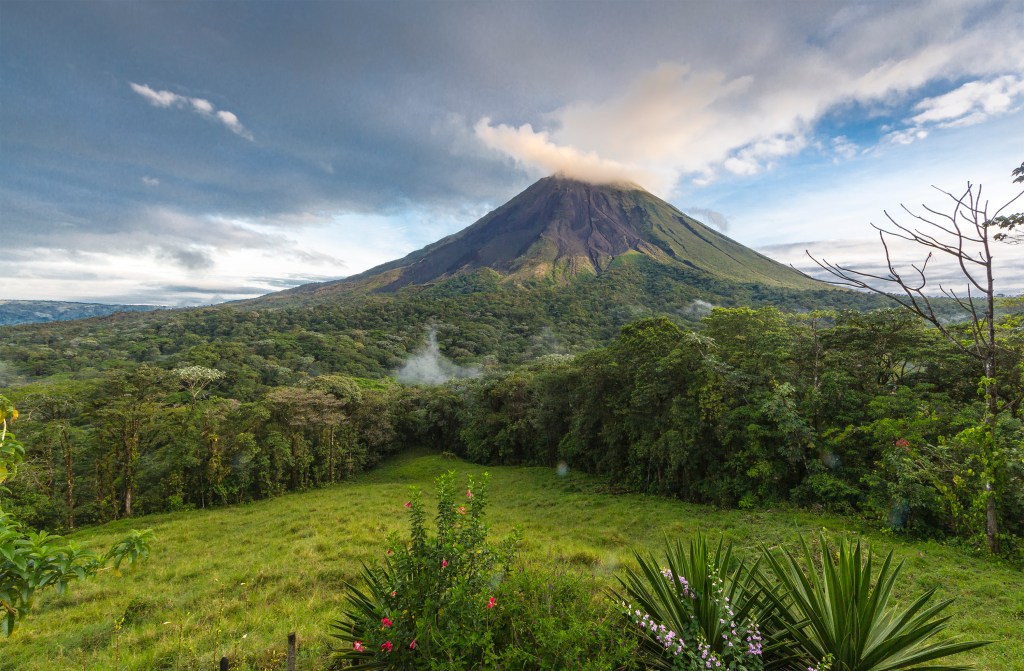
A still-active Arenal Volcano sends wisps of smoke into the sky.
Active since July 1968, the volcano dominates Arenal Volcano National Park, which provides a wide variety of activities for adventure travelers to enjoy, such as hiking, kayaking, kite surfing, whitewater rafting and rappelling down waterfalls.
Central Valley
San José, the capital of Costa Rica, lies within the Central Valley; many of the country’s most popular museums are found here. Blend cultural experiences with your outdoor adventures by visiting the Gold Museum, the Museo del Jade and the Museo Nacional de Costa Rica. If you’re traveling with children, there’s also the Museo de los Niños (Children’s Museum) in San José to keep the little ones entertained, especially if it rains during your trip.
Of course, the outdoors beckons in the Central Valley, too. At the northern end, Braulio Carrillo National Park is set between the Poás and Irazú volcanoes and is one of Costa Rica’s largest protected areas. Barva and Cacho Negro volcanoes rise within the park. With the higher elevation comes lower temperatures, so be sure to pack warm layers if you visit.
Central and South Pacific
Adjacent to the Central Valley, but on the coastline, is the Central Pacific, and here we find another Costa Rica favorite, Manuel Antonio National Park. A glimpse into the park reveals its appeal: The white-sand beaches, turquoise waters and lush vegetation seemingly call out, just like the birds teeming in the trees. Aside from the park, several of the country’s most-visited cities are in the Central Pacific region, too, including Quepos, Jacó and Puntarenas.
Follow the coastline south to find the aptly-named South Pacific region. Here, beaches are the main focus, with plenty of protected areas to explore. Marino Ballena National Park is one such area, known for its iconic protrusion of land—shaped like a whale tail—that reaches into the ocean. This is a great place to look for humpback whales.

Great surfing can be found in many parts of Costa Rica!
Corcovado National Park is found in the South Pacific region, too, and is the largest of Costa Rica’s parks at more than 103,000 acres. From the beach, the park meanders through lagoons, marshland, mangrove swamps and rivers as it reaches into a low-altitude cloud forest.
Caribbean
On the other side of the country is the Caribbean region, an area that covers more than 5,000 square miles, of which 200 miles is coastline. In addition to Cahuita and Tortuguero national parks and the Barra del Colorado National Wildlife Refuge, the city of Puerto Limón (or simply Limón) is also found within the Caribbean region.
Culturally, this area of Costa Rica is known for its Afro-Caribbean culture, which can be seen, heard and tasted in the Cahuita, Puerto Viejo and Gandoca-Manzanillo areas to the south.
Top Outdoor Activities in Costa Rica
1. Hiking
Whether you’re a novice who’s lacing up boots for the first time, or an accomplished thru-hiker, there are plenty of opportunities throughout Costa Rica for hikers of all experience levels, in all types of landscapes, from coastlines to waterfalls to mangrove swamps to cloud forests.
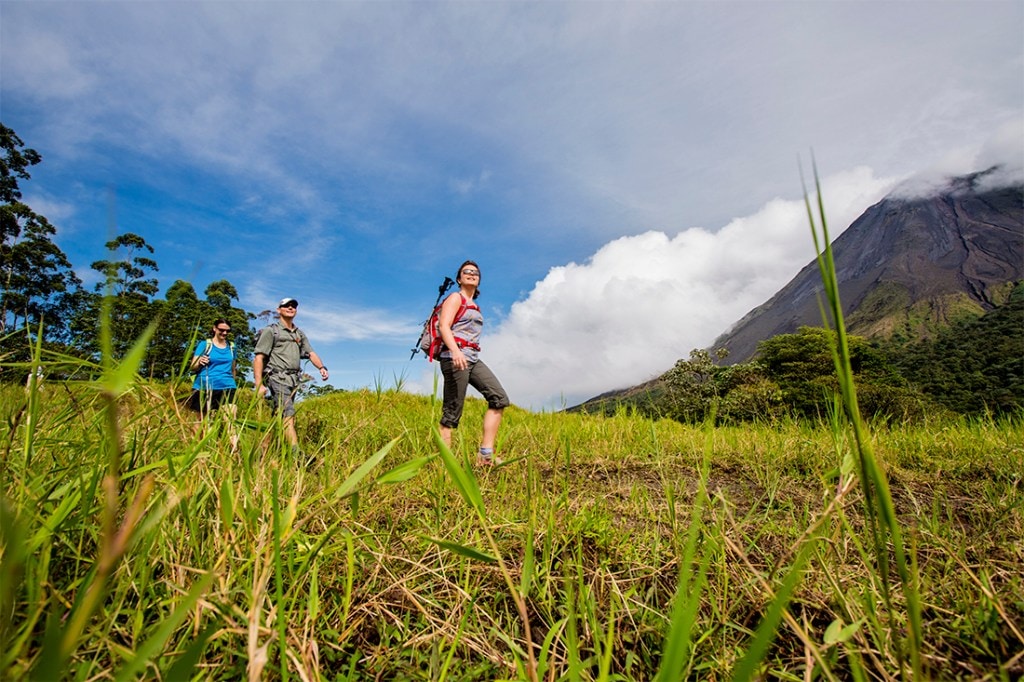
Hikers enjoy the grand aesthetic of Arenal Volcano National Park.
Hiking paths and trails within the country’s national parks are easily accessible for the most part, and you may encounter hanging bridges to link trails together.
When you’re ready to take your hiking to a different level—literally—go underground and try cave hiking in the Venado Caverns in Arenal Volcano National Park. Or go to new heights and hike the highest peak in Central America, topping out at 12,500 feet atop Cerro (Mount) Chirripó in the Talamanca Mountain Range within Chirripó National Park.
A note: Although not required, the Costa Rica Tourism Board suggests hiking with an expert tour guide to “learn the secrets of the flora and fauna.”
2. Diving and Snorkeling
With its hundreds of miles of coastline along both the Pacific Ocean and Caribbean Sea, not to mention its many rivers and volcanic lakes, there are plenty of places to enjoy the water in Costa Rica.
Dive in—with a snorkel or scuba tank—and view the undersea world in Cahuita National Park, where you’ll find one of Costa Rica’s most important coral reefs. Here more than 120 species of fish and 40 species of crustaceans can be spotted. For even more aquatic adventure below the surface, be sure to check out Marino Ballena National Park.
3. Whitewater Rafting and Paddling
The thrill of whitewater rafting is found on the Rio Pacuare, the longest river in Costa Rica, and the most popular. While paddling the river, be sure to keep an eye out for wildlife, including Capuchin monkeys, toucans and sloths. More whitewater rafting opportunities are found along the Sarapiquí and Savegre rivers, as well as in Guanacaste.
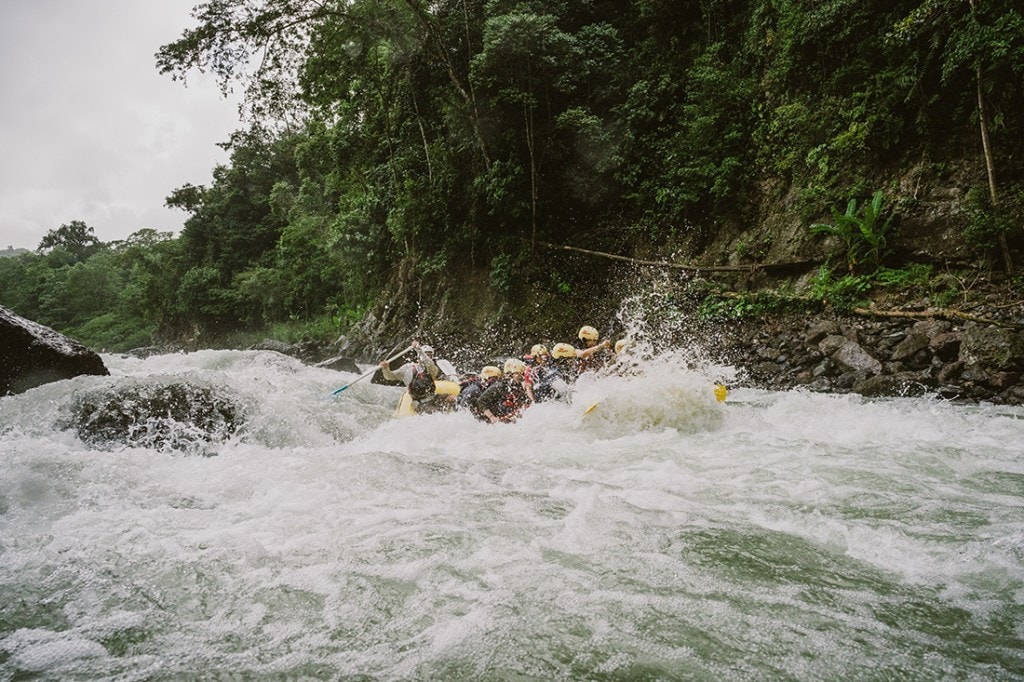
A rafting group plows through a standing wave on the Rio Pacuare.
For a slower pace, hop into a canoe or kayak. Some of the spots considered great for paddling are Lake Arenal within Arenal Volcano National Park, Río Corobicí and Río Pacuare. Or take to the open waters and go sea kayaking. Experienced sea kayakers will delight in paddling in the Pacific Ocean; top spots are the islands off of Puntarenas, and around the horn of the Nicoya Peninsula, just off of Cabo Blanco Nature Reserve, Costa Rica’s first national park, established in 1963. Another sea-kayaking spot to consider is along the coastline of Manuel Antonio National Park.
4. Surfing
Costa Rica beckons experienced surfers as well as novices who are ready to catch a wave. Surf spots can be found in four regions throughout the country—the Caribbean coast, the Northern Pacific coast, the Southern Pacific coast and the Central Pacific coast. Of the four areas, the greatest density of surf spots are found on the Pacific coast, and more specifically, in the Guanacaste region; Tamarindo Beach is considered the country’s surfing mecca.
Other top Costa Rican surfing beaches along the Pacific Ocean include Hermosa Beach, considered to have some of the most consistent waves in the world; and Pavones Beach, with waves that go on for more than half a mile. Experienced surfers will want to travel to the Caribbean side and catch the strong breaks with massive tubes at Puerto Viejo, also known as Salsa Brava.
5. Wildlife Viewing
Part of what attracts so many people to Costa Rica is the opportunity to view wildlife in its natural habitat, whether in the air, on the land or in the sea.
In the Guanacaste Conservation Area, in addition to spotting the various monkey species that call the region home, astute watchers may be able to spot tapirs, sloths and even jaguars as they migrate through the park toward the Cacao Volcano.
Costa Rica offers prime birding, with ample opportunities to add myriad species to your life list. In fact, an estimated 900 bird species can be spotted throughout the country, with only about a half-dozen endemic to Costa Rica.
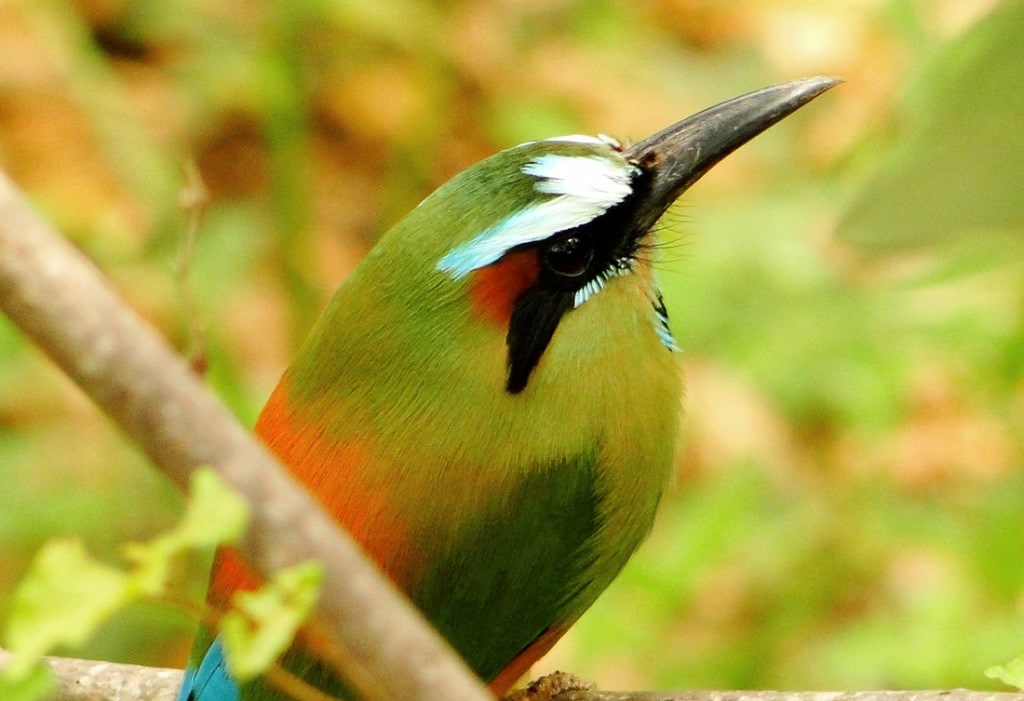
Costa Rica’s tropical habitats make the country one of the top birding destinations in the world.
In fact, the country has an established Costa Rican Bird Route, which is composed of 12 regional sites where enthusiasts can spot and identify the 900 species that call the country home, as well as about 220 species that migrate through seasonally.
A good place to start is in Arenal Volcano National Park, which boasts 75 percent of the country’s bird population, and in Monteverde, keep an eye out for the colorful quetzal. Another top birding spot is Cerro de la Muerte, or the Mountain of Death, one of the highest peaks within the country. For a glimpse of the scarlet macaw, visit Carara National Park.
During whale-watching season (mid-July through October and December through March), humpback whales migrate to Marino Ballena National Park to nurse their young, providing terrific opportunities for whale watching from the park’s beaches. Spotted and bottlenose dolphins may also be seen, as well as manta rays.
One of the largest green sea turtle nesting beaches in the Western Hemisphere is found in Tortuguero National Park, on the Caribbean side. The beaches here are heavily protected to conserve the greens, as well as leatherback and hawksbill sea turtles. Join a guided tour and, if you’re lucky, watch the turtles lay their eggs in the moonlight.
Wherever you travel in Costa Rica, as a rule of thumb, be sure to keep an eye on the treetops in search of the monkeys and sloths that make their homes high above the ground. A terrific spot to see some of each is Manuel Antonio National Park.
How to Plan Your Trip
Best Time to Visit Costa Rica
Costa Rica’s location on the skinny part of the Central America isthmus gives it two distinct sides: the Pacific and the Caribbean. Each has its own weather patterns, but generally, the best time to visit Costa Rica is December through April.
On the Pacific side, the dry season is traditionally December through March, with March being the driest and hottest month. The rainy season runs May through October, with September and October usually the rainiest months. April and November are considered transition months, bridging the two seasons.
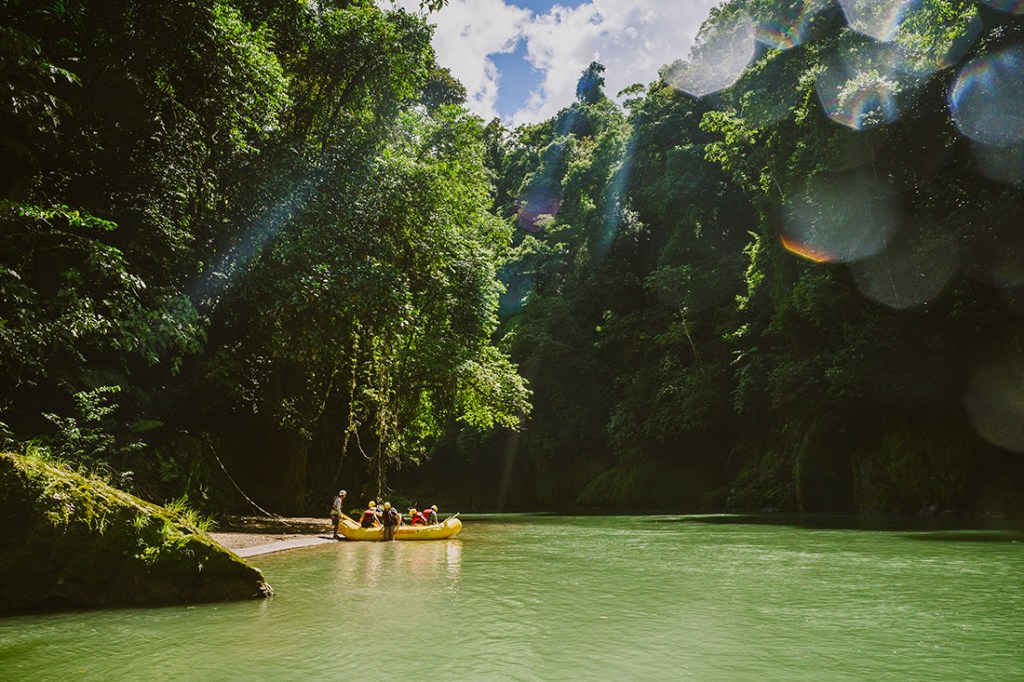
The rivers of Costa Rica offer white water and a rich world of natural beauty.
Over on the Caribbean side of Costa Rica, there isn’t a well-defined dry season, since rainfall accumulates in what could be considered the driest months. Rather, travelers can experience two relatively dry periods—the first during February and March, and the second during September and October. The rainiest month in this region is December.
What to Pack
With its varying seasons from the Pacific to the Caribbean, not to mention its towering mountain ranges and sandy beaches that each foster their own microclimates, it’s important to consider what to pack before boarding your flight to Costa Rica.
Year-round average temperatures vary from 70 to 81 degrees Fahrenheit, and at higher elevations, temps can dip into the low 40s to high 50s. Layers are always a good idea, as is raingear if you’re visiting during the rainy season or heading to the rain forest. Solid hiking shoes are a good bet, as well as water shoes for undertaking amphibious adventures. Speaking of agua, the water temperature on both the Pacific and Caribbean coasts pretty much holds steady at 84 degrees year-round.
Coming and Going
When booking flights to Costa Rica, there are two airports from which to choose: Juan Santamaría International Airport in San José, the capital city which is in the middle of the country; and Daniel Oduber International Airport in Liberia, which is in the northwest. Whichever you choose, U.S. and Canadian citizens are required to carry a valid passport, as well as proof of arrival and departure tickets. There is an exit tax of $29 that must be paid in order to depart the country.
Although Spanish is the official language of Costa Rica, English is also widely spoken. Similarly, the official national currency is the Costa Rican colón (CRC), though U.S. dollars are widely accepted, as are credit cards.
What to Eat and Drink
When it comes to eating and drinking, you’ll find plenty of options to keep you satiated in Costa Rica, from five-star dining to sodas (small restaurants) to local markets such as the Mercado Central (Central Market) in San José, the largest and oldest in the city.
Start the day with a traditional dish of gallo pinto for breakfast; it also happens to be Costa Rica’s national dish—rice and beans, often prepared with red peppers, cilantro and onions for a little kick. Gallo pinto may be served on its own or with eggs, bread and a cup of coffee or juice. Another dish to try is casados, essentially a plate of rice and beans served with meat or fish, salt, fried plantains, cheese and a corn tortilla.

Sifting through one of the country’s most important crops, a traveler visits a coffee farm in Costa Rica.
Coffee aficionados will certainly want to take advantage of the rich beans harvested and roasted where they are grown. Coffee farm tours, like those at Espíritu Santo in Alajuela, are also available so that you can learn about the process, from bean to brew.
Where to Stay
Accommodations throughout Costa Rica vary to suit every traveler’s needs and budget, from surf-town hostels to eco-lodges, oceanside all-inclusives, and chains you’ll recognize in the city.
Keeping with the country’s environmental focus, the Costa Rica Tourism Board developed the Certification of Sustainable Tourism (CST) program; this seal of approval acknowledges hotels throughout the country that are sustainable in their operations in regards to natural, cultural and social resource management.
How to Get Around
Rental cars are available at airports and in larger cities across the country. To get your bearings upon arrival, plan to visit the official Tourist Information Center in downtown San José or at the Daniel Oduber International Airport in Liberia. The staff at either can also help you navigate the bus system to get you where you need to go. In larger cities, taxis are readily available for quick trips.
If you’re short on time and want to squeeze in as much of Costa Rica as you can during your visit, consider flying from one region to the next. Airlines flying domestically include Aerobell Airlines, with 11 daily flights to destinations throughout the country; and Sansa Airlines, which serves over a dozen destinations in Costa Rica.
No matter what you choose to do when traveling to Costa Rica, amazing adventure awaits!
